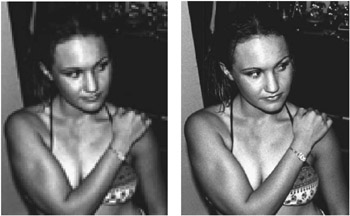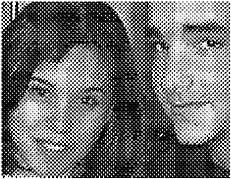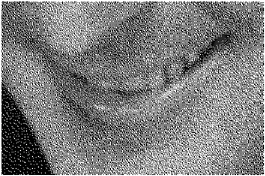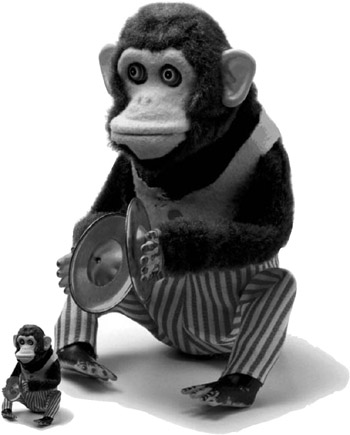What Is Resolution?
Resolution determines the quality of an image and the amount of detail that can be displayed or printed. There are several important terms relating to resolution that you should know:
Image resolution The number of pixels that occupy a linear inch of a digital image, usually measured in pixels per inch (ppi).
Monitor resolution The number of pixels that occupy a linear inch of a monitor screen (72 ppi for most Macintosh RGB monitors, 96 ppi for Windows VGA monitors ). This resolution never changes, as it represents the physical matrix of the monitor.
Image size The height, width, and resolution of an image.
Printer resolution The number of dots that can be printed per linear inch, measured in dots per inch (dpi). These dots compose larger halftone dots on a halftone screen or stochastic (random pattern) dots on an ink-jet printer.
Halftone screen The dot density of a printed image, measured in lines per inch (lpi) or, in rare instances, lines per centimeter (lpc). A halftone screen is a grid of dots. The tonality of a printed image is determined by the size of the dot within the specific matrix. Table 13.1, later in the chapter, lists some standard values.
| VALUE | DEFINITION |
|---|---|
| 60 lpi | This value produces a coarse halftone screen, suggested for screen printing. |
| 85 lpi | This value works well for newsprint and porous paper stock. |
| 133 lpi | This value produces finer detail. It s used on web presses for printing medium-quality weekly magazines, books, and other jobs on uncoated paper. |
| 150 “175 lpi | These frequencies are suitable for brochures , pamphlets, and commercial printing on coated stock. |
| 200 “300 lpi | These values produce the finest images with lots of detail and color depth. You might use this option when creating annual reports or fine art prints. |
Optical systems enable us to capture and organize visible light. Each type of optical system breaks up light in its own unique system of units. Though each system determines resolution differently, the more information that can be collected or printed, the better the quality of the image. Let s take a look at reality through several optical systems and see how they work.
The Human Eye
Probably the most perfect optical device is the human eye. Our eyes collect light through a lens called the cornea and focus it on a light-sensitive field called the retina . Color and tonal information are transmitted through the optic nerve and interpreted by the brain into a completely continuous-tone reality. When an image is continuous-tone, there are no visible divisions between colors and shades. Our eyes enable us to see reality as a seamless fabric of color and form. The closer we look at something, the more detail we perceive.
| |
The terms dots per inch (dpi), pixels per inch (ppi) and lines per inch (lpi) are often confused . Manufacturers often refer to the resolution capabilities of their scanners in dpi, but a scanner creates pixels and a printer prints dots. In this book, I use ppi when referring to pixel resolution from a scanned image or digital camera, or on a monitor. I use dpi when I refer to the output of a printer, and lines per inch (lpi) for the screen frequency of a halftone screen.
| |
The Traditional Camera
The traditional camera is a mechanical replica of the human eye. It, too, collects light through a lens and focuses it on a light-sensitive field ”but this field is made of film or paper coated with chemicals called emulsions that, when developed, respond to light. The grain of the emulsion determines the maximum visual depth of the image. Photographic grains are microscopic, which enables photographic images to be produced at exceptionally high quality. Even though photographs are described as continuous-tone in the industry, when a photograph is enlarged too much, its grains become visible, which can diminish its quality.
Scanners and Digital Cameras
The scanner and digital camera are two other optical devices that see tonality and color. In Chapter 14, Image Capture and Digital Photography, I discuss how these devices work in more detail. Suffice it to say that scanners and digital cameras collect red, green, and blue color information and interpret it into pixels. Like all digital information, these pixels are assigned numbers that identify their color content. A computer is needed to decipher these values. A video card and monitor are necessary to display them. Because the image is constructed of individual units of color, it is a mosaic of colored squares. Each pixel is like an individual building block. The more pixels contained within the image, the more information there is, and hence, the more detail that can be displayed (see Figure 13.1).

Figure 13.1: Identical images at different resolutions : the image at 30 ppi (left) and the image at 300 ppi (right)
| Note | Should a pixel-based digital image be considered continuous-tone or not? That s a matter of ongoing debate in the industry. One of the best discussions of this issue can be found at www.deluxacademy.com/articles/digitalphoto/ contone .html. |
Halftone Screens
Printing an image with ink on paper presents a unique set of problems. How does a mechanical device such as a printer communicate tonality to a flat piece of paper? Because the printer must distribute ink, it needs a method that will portray the tonal range without smearing the ink. To accomplish this task, printing technologies divide the ink into individual dots on a grid called a halftone screen. On traditional halftone screens used for black-and-white images, the size of the dots determines the darkness or lightness of an area (see Figure 13.2). Areas on the screen that contain larger dots are darker than areas with smaller dots (which enable more of the paper to show through, providing a lighter perceived tone).

Figure 13.2: A halftone screen, enlarged to show tonal density
With full-color images, four different-colored halftone screens called color separations ” one each of cyan, magenta , yellow, and black ”are used. These colors combined in varying densities on the screens can produce a full range of color. The finer the halftone screen, the more detail can be displayed. The line frequency of the halftone screen is determined by the type of printing that is being performed. Table 13.1 lists common line frequencies used in various types of printing.
| Note | Screen frequencies higher than 200 lpi are not as common as 175 lpi or less. The physical demands of printing finer screen rulings often prohibit their successful use. To avoid difficulties, ask your print shop early in the process about stock requirements and other details related to the choice of screen frequency. |
Ink-Jet Printers
Some ink-jet printers produce colored dots similar to a halftone screen when viewed from a distance. These ink-jet printers, however, use a stochastic, or frequency modulated, screen to produce tonality. A traditional halftone screen is a grid with a fixed number of lines. The size of the dots within the grid varies, which produces variations in color and tone. A stochastic screen, however, deposits dots of a uniform size. Instead of the size of the dot, it is the number and distribution of dots that determine tonal value and color density (see Figure 13.3).

Figure 13.3: A stochastic screen, enlarged to show tonal density
Image Resolution vs. Monitor Resolution
Image resolution refers to the number of pixels per linear inch collected at the scanner or digital camera. The monitor resolution is a fixed matrix of pixels. When an image with the same resolution as the monitor is displayed at actual size, it appears at its actual physical size, because at 100%, one image pixel equals one monitor pixel. If the image has a higher resolution, it will appear larger than its physical size. For example, a 4 ² —5 ² image that is 288 ppi will appear four times larger at 100% than an image that is 4 ² —5 ² at 72 ppi (288 = 4 — 72). If you copy and paste (or drag and drop) an image that is the same physical size but a lower resolution to a document of higher resolution, the pasted image will reduce in physical size (see Figure 13.4).

Figure 13.4: The small monkey was dragged and dropped from a 72 ppi file that was 6 ² wide by 7.2 ² high onto a file that was the same physical size but with a resolution four times greater, or 288 ppi.
To see a preview of the printed size of an image, choose Print Size from Photoshop s View menu. The image displays at the size at which it will print, no matter what its resolution.
EAN: 2147483647
Pages: 355